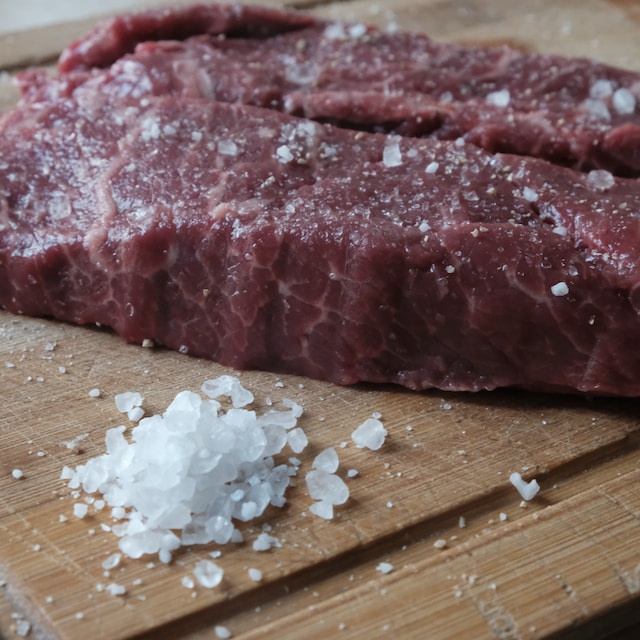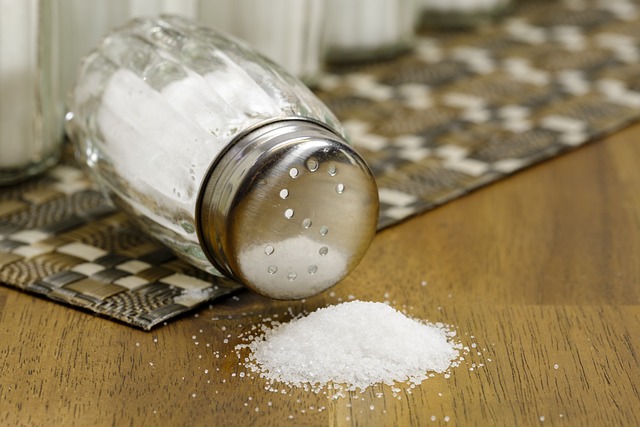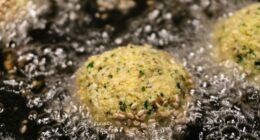Canning salt is ideal for preserving food as it does not contain any additives or anti-caking agents that may affect the quality of canned goods. Regular table salt has iodine added to it, which makes it an excellent choice for daily cooking and seasoning.
What is canning salt?
(Photo by Louis Mornaud on Unsplash )

Canning salt, as the name suggests, is a type of salt that’s used in canning and preserving foods. Unlike regular table salt, canning salt is free from any additives like iodine or anti-caking agents that may impact the taste or color of canned food.
One of the reasons why canning salt is preferred for preserving foods is because it dissolves quickly and evenly in water. This helps to ensure consistent flavor throughout the jar and prevents clumping that could lead to spoilage.
Another benefit of using canning salt over regular table salt is its fine-grained texture. The small particle size makes it easier to measure out precise amounts for recipes, ensuring accurate results every time.
It’s important to note that while some people may use sea salt or kosher salt for canning purposes, these types of salts aren’t recommended due to their varying mineral contents, which could affect preservation quality.
In summary, if you’re looking to preserve your own fruits and vegetables at home using a pressure cooker or boiling-water bath method, then investing in some high-quality canning salt will help you achieve great tasting results with ease!
What is regular salt?
(Image by Bruno /Germany from Pixabay )

Regular salt, also known as table salt or iodized salt, is the most commonly used type of salt in households. It’s made by mining underground deposits of sodium chloride and processing it to remove impurities. The resulting product is then mixed with small amounts of anti-caking agents such as calcium silicate or magnesium carbonate to prevent clumping.
One important characteristic of regular salt is that it contains added iodine, a mineral that helps maintain healthy thyroid function and prevent goiter. Other minerals present in regular table salt include potassium, calcium, and magnesium but in very small amounts.
Regular salt has a fine texture and dissolves easily making it perfect for cooking and seasoning food. It’s often used on top of popcorns, fries or any other dish where its coarse texture can be appreciated.
However, too much consumption of regular salt may lead to health issues such as high blood pressure which increases the risk of heart disease and stroke. Therefore moderation when consuming this type of salt is crucial for maintaining good health.
Canning salt Vs. Regular salt – Key differences
When it comes to canning, there are specific types of salt that work best. Canning salt is one such type, which is pure and free from any additives like iodine or anti-caking agents. On the other hand, regular table salt may contain these additives and may not be as pure.
Another key difference between canning salt and regular salt is their grain size. Canning salt has a very fine grain size, while regular table salt often has larger grains. The smaller grains make it easier for canning salt to dissolve uniformly in liquids like brine.
Canning salts also have a higher density compared to regular table salts. This means that you need less of it by volume when measuring out how much to use in a recipe.
Canning salts are specifically designed for preserving food through the process of canning. They help maintain the crispness and flavor of pickled vegetables without clouding or discoloring the liquid they’re preserved in.
While both types of salt may seem similar on the surface level, their differences become apparent when used for specific purposes like canning. It’s important to use the right type of salt depending on your recipe so you get optimal results every time!
How to use canning salt?
Canning salt is a type of salt that is specifically designed for use in preserving foods through canning. It has a fine grain size and does not contain any additives or anti-caking agents, making it ideal for use in pickling brines and other canning recipes.
When using canning salt, it’s important to follow the recipe carefully and measure out the correct amount of salt as specified. Too little can result in spoilage, while too much can make your food overly salty.
One common way to use canning salt is in pickling vegetables like cucumbers, beets, and green beans. Simply combine the salt with vinegar and water along with any desired seasonings to create a flavorful brine.
Another popular application for canning salt is in creating homemade salsa or tomato sauce. By adding just the right amount of this pure sodium chloride to your recipe, you’ll help ensure proper preservation without affecting flavor.
Using canning salt requires care and attention to detail but will ultimately result in delicious preserved foods that last longer than fresh produce alone.
Recipes that use canning salt
Canning salt is a type of salt used for preserving food through canning. It has no additives, which makes it ideal for pickling and preserving. Canning salt is typically used in recipes that require precise measurements to ensure the correct ratio of salt to liquid.
One recipe that uses canning salt is pickles. Cucumbers are soaked in a brine made with water, vinegar, sugar, and canning salt. The cucumbers absorb the flavors from the brine while remaining crisp due to the use of canning salt.
Another popular recipe that requires canning salt is sauerkraut. Shredded cabbage is mixed with caraway seeds and spices before being packed tightly into jars with water and canning salt. The mixture ferments over several weeks, creating a tangy flavor that pairs well with grilled meats or hot dogs.
Canning also extends to fruits such as jams and jellies where fruit slices or purees are boiled down with sugar until they thicken into jam-like consistency or become jelly when strained removing fibers but retaining pectin content.
There are many recipes out there that utilize canning salts’ unique properties like its purity and precise measurement requirements which not only help preserve your favorite foods but also give them an added layer of flavor!
What happens if you use regular salt for canning?
Using regular salt for canning can have negative consequences. Regular table salt contains iodine and anti-caking agents, which can discolor the food you’re preserving. Additionally, it may cause cloudiness in your brine solution or pickling liquid. This is because iodized salt has additives that don’t dissolve as well as pure sodium chloride.
Furthermore, using regular salt may also affect the taste of your canned goods. The presence of anti-caking agents and iodine may create a metallic or bitter flavor, altering the intended taste of your recipe.
In addition to affecting taste and appearance, using regular salt instead of canning salt could also impact safety. When you preserve foods through canning or pickling methods, it’s crucial to maintain proper acidity levels to prevent bacterial growth and spoilage. Canning salts are made without additives that could interfere with this process while regular table salts do contain these impurities.
Always use specifically labeled “canning” or “pickling” salts when preserving foods to ensure both a high-quality end product and safe consumption for you and those who enjoy your creations!
What is Himalayan salt?
Himalayan salt, also known as pink salt or rock salt, is a type of crystalized salt that is harvested from the Khewra Salt Mine in Pakistan. It gets its distinctive pink color from the presence of iron oxide.
This type of salt is often marketed as a healthier option compared to regular table salt because it contains trace minerals such as magnesium and potassium. However, the amount of these minerals present in Himalayan salt is negligible and won’t make much difference to your overall health.
One unique feature about Himalayan salt is that it can be used for cooking on high heat due to its high mineral content which helps it retain flavor even at high temperatures.
Another popular use for Himalayan salt is in making decorative lamps and candle holders. When illuminated with an electric bulb, the lamp gives off a warm glow that some people find soothing and therapeutic.
However, there are concerns over sustainability issues surrounding harvesting this type of specialty product. Additionally, there have been reports questioning whether all brands labeled “Himalayan” actually come from Pakistan’s Khewra Salt Mine.
Advantages and disadvantages of canning salt and regular salt
Canning salt has its own set of advantages and disadvantages. One advantage is that it does not contain any additives like iodine or anti-caking agents, which can affect the taste and appearance of canned foods. Another advantage is that it dissolves easily in water, making it ideal for use in pickling brines.
On the other hand, one disadvantage of using canning salt is that it may be more expensive than regular table salt due to its purity. Additionally, because canning salt contains no iodine, those who rely on canned foods as a primary source of nutrition may need to supplement their diet with other sources of this essential mineral.
Regular table salt also has both advantages and disadvantages. One advantage is that it’s widely available and relatively inexpensive compared to specialty salts like sea salt or Himalayan pink salt. It also contains iodine, an essential nutrient for thyroid health.
However, regular table salt may contain additives like anti-caking agents or dextrose which are added to prevent clumping but could impact the flavor of food when used for canning purposes. Furthermore, some people find regular table salt too harsh or salty-tasting for certain recipes.
Ultimately deciding between canning salt Vs. Regular Salt comes down to personal preference based on factors such as cost and nutritional needs/preferences.
Featured Image By – Jason Tuinstra on Unsplash








